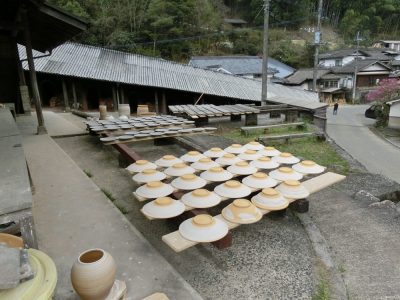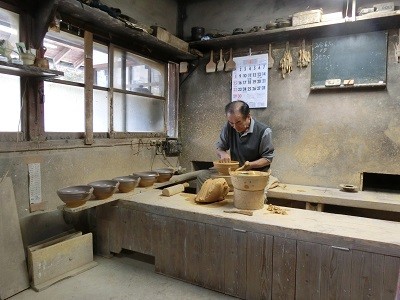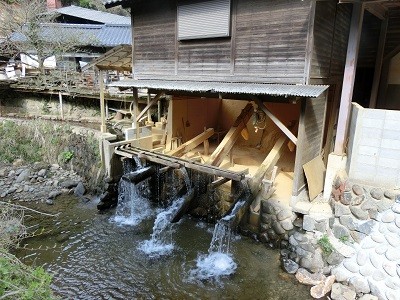Onta is a small village in Hita City in Oita Prefecture, Kyushu. It is famous for the Japanese pottery they produce using traditional techniques. Let’s find out more about Onta’s artisanal products and attractions for visitors of this off-the-beaten-path destination!

Hita City
Hita is a small city in the western part of Oita Prefecture in Kyushu with a population of about 60,000 people. The city lies in a basin surrounded by mountains. It was an important city during the feudal time because it was a transportation hub accessible from the major cities in Kyushu. These cities are Fukuoka, Nakatsu, Oita, and Kumamoto. This is why the city was taken by the Tokugawa Shogunate.
During the Edo period when the Tokugawa family kept the title of Shogun from 1603 for more than 260 years, each area was governed by 250 daimyo or feudal lords. But important cities such as Takayama where high-quality lumber was produced were controlled directly by the shogunate. The magistrate office controlled the whole of Kyushu Island.
Many rivers flow from the mountains into the city and the rivers were used to transport products like lumber to other cities. But river transportation stopped once the Yoake Dam was constructed for electric power generation in 1954.
History of Onta
Onta is located in the northernmost part of Hita City. It takes about 30 minutes by car from the center of Hita. The production of pottery started in Onta in 1705 by Yanase Sanemon. He was a pottery artisan of the pottery village Koishihara in Fukuoka.
Kuroki Jubei who lived in Hita invited him and they tried to find a good place for the production of pottery. They finally founded a kiln in Onta because of its characteristics that made it a good place for creating pottery. There was good clay, abundant lumber to use for the firing, an ideal slope to make a climbing kiln, and a river to generate waterpower.
Production of Onta Pottery
There are only 10 pottery workshops in Onta. They traditionally hand down their techniques from father to one of his sons. Employing only traditional techniques, they don’t use electric power. They use manual pottery wheels, climbing kilns, and water wheel-driven pounders. Japan still has many pottery towns, but it is rare to see this old style anywhere else.


When you enter the village, firstly, you will recognize the sound of the pounder near the river. You can see how the water-power wooden machine pounds the clay. It is really unique! When you continue to walk along the street, you will see plates that are placed in front of houses to dry before firing and you will find that the house is a workshop. Some workshops are welcoming visitors. They will show you how they operate the manual pottery wheels.
You can buy their products at the workshops. A popular pattern is “tobikanna” which is a simple design consisting of short sharp lines. You may also find a jar with a handle that is not a traditional Japanese utensil. This design was influenced by the western tableware introduced to Nagasaki by Dutch traders through the East India Dutch Company. Dejima in Nagasaki was the only port open to Dutch traders while Japan closed the rest of the country for nearly all foreigners.
It is very interesting just walking along the street of Onta. Including the workshops and wooden pounders, there are many traditional wooden houses. Onta is designated as one of the Important Cultural Sceneries of Japan by the Ministry of Culture.
Visit of Bernard Leach
In the 20th century, British artist Bernard Leach came to Japan and visited many workshops all over Japan. He joined the Mingei (folk craft) movement which was started by Yanagi Muneyoshi known as Soetsu. Yanagi saw the beauty of tools made by nameless artisans and started the movement in 1926.
Leach started Leach Pottery in 1922 in Britain with Japanese potter Hamada Shoji. Leach also helped the foundation of the Japan Folk Craft Museum in Tokyo. After Leach visited Onta in 1954, they participated in an international craft contest and won the grand prix. That was the moment when Onta pottery became very famous.
Your Japan Tour
As seasoned Japan experts, we can help you create your perfect Japan tour including guides who can tell you all about Japanese pottery. The guide can take you to the Onta Village and some of the workshops if you wish. Contact us to start planning your unforgettable holiday to this fascinating country. Japan is full of once-in-a-lifetime experiences, culture, history, nature, and delicious food!
Onta Access Information
Access: From Hakata (the big terminal in Kyushu), take a shinkansen to Kurume, then change to the Kyudai Line and get off at Hita Station. It takes about 1 hour 40 minutes. From Hita Station, it takes 40 minutes by bus to the Sarayama stop.